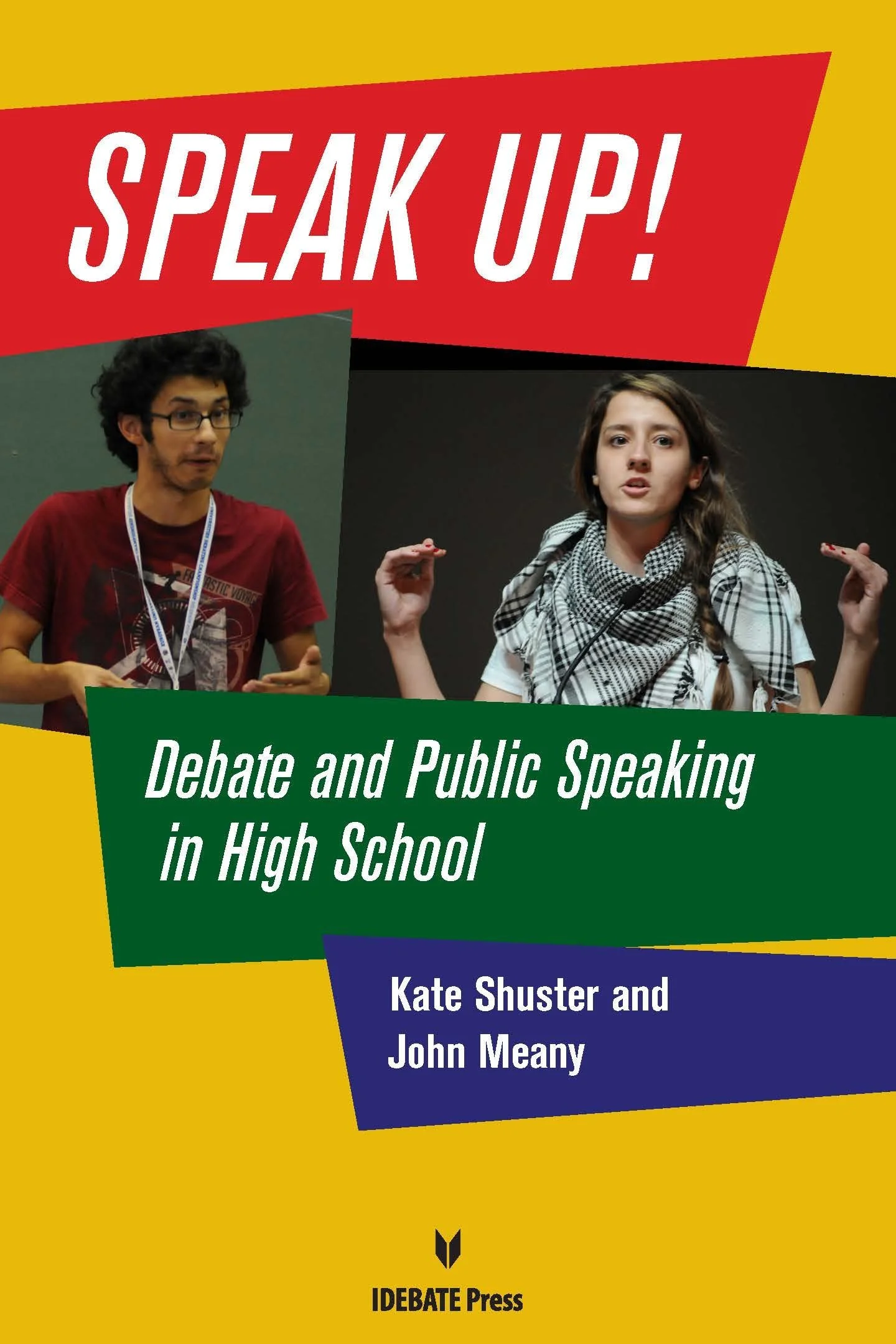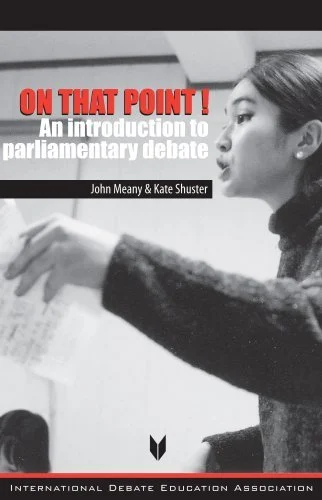Basics of Argumentation
A-R-E-S-R
Arguments are the building blocks of effective debating. An argument is a sophisticated idea. It is not simply the expression of an opinion. A debate argument is an idea (assertion) that is developed using logical analysis (reasoning) and empirical proof (evidence). An argument is amplified – made credible and convincing – by demonstrating that it matters (significance) and is better than opposing or competing arguments (result). A well-designed debate argument should explain that it makes more sense than, is more likely to be right than wrong than, is more urgent or important than, and is more favorably compared to the major arguments presented by the opposing side in a debate. Effective arguments have more substance and are more persuasive.
Concept
ASSERTION – the label for an argument
Also known as an introductory sentence, hypothesis, signpost, or claim, the assertion is a brief, as yet unsupported, statement describing an argument
EVIDENCE – information from experience or observation
Statistical information, historical and current examples, expert testimony, personal stories and biographies, and hypotheticals based on defensible facts (for example, IFTTT, ‘if this, then that’) – evidence verifies reasoning; it shows that a logical explanation also matches our understanding of the facts of the world
Example
Sample Topic – BAN UNPAID INTERNSHIPS!
A – Unpaid internships do not offer job protection
REASONING – the logical analysis supporting an assertion
An analysis, explanation, and justification for an assertion; an effective prompt to produce reasoning is to add ‘because’ to the end of the assertion
R – Despite serious work on the job performed by interns, exceptions in the Fair Labor Standards Act (FSLA) allow employers to deny minimum wage pay, job benefits, and protection against harassment to interns. Employers take the exceptions to save money – interns do the work without any traditional job benefits.
E – The FSLA exceptions are taken by businesses in fashion, film, music, and law .To get an exception, the employer must provide an academic benefit to interns as a substitute for job benefits. Many employers do not offer any such support and schools give no course credit. Some of the leading employers in the US face lawsuits for their treatment of interns – Sony, Fox Searchlight, Warner Bros., Conde Nast.
SIGNIFICANCE – the qualitative and quantitative importance of an argument
Qualitative significance explains the importance of an issue or degree of change in an individual case. Quantitative significance explains the number of individual cases. In other words, how much does this issue matter and to how many people?
S – Interns work without the kind of protections guaranteed by the Universal Declaration of Human Rights. They work without pay; they are not treated equally although they do the same work as other employees; they do not receive training. According to Intern Bridge in September 2013, more than 200,000 interns worked without legal protection and without academic benefit last year.
RESULT – a proof or the comparative value of an argument
The result of an argument position is that it helps a team win a debate. For example, like an issue that cannot be refuted effectively in a court of law, an argument might establish a convincing proof in support of a case for a topic. As a comparison, result is the method of evaluating an argument against the issues introduced by the opposing side of a debate. A debate team must be able to convince a judge that their arguments are superior to the opposing team’s arguments. The best approach – prove that each major argument for your team is superior to the sum total of your opponents’ arguments.
R – It is unethical to abuse workers this way. Over the course of several years, hundreds of thousands of workers have no benefits, no protections. Unpaid work and internship status means a serious loss of income, as well as little training and protection for the most vulnerable workers – students, the unemployed. In addition, it is a clear violation of Article 23 of the Universal Declaration of Human Rights’ wage and equal protection rights for workers. This is a dangerous precedent. It may become an excuse for other countries and multinational corporations to convert jobs to internships in order to strip rights from workers. For ethical and practical reasons, the practice of unpaid internships must end.
Basics of Refutation
4-Step Method
Debating involves the construction and development of arguments. It also includes disagreement – efforts to undermine, erase, and overpower the arguments presented by an opposing team. One technique for learning core refutation is the 4-Step Method of Refutation. This is a primary critical thinking tool – it is a mental representation of disagreement. Comprehensive refutation includes diverse techniques. Some of them even involve strategic agreement. But disagreement is a foundational element of argument clash (Argument A v. – [negative] Argument A). The 4-Step Method teaches students to block a well-developed and opposing idea.
Concept
STEP 1 – They say . . .
An answer should begin with the precise language used by an opponent. It should not be a generalization about an opponent’s position. Specificity is required.
STEP 3 – Because . . .
This is the argumentation stage of the method. To disagree, it is necessary to make an argument of one’s own – ARE + S that is, Assertion, Reasoning, Evidence, Significance... STEP
Example
Sample Topic – Lower the voting age.
My opponent stated “a lower voting age would produce more public policies for the benefit of youth.”
STEP 2 – But I disagree . . .
This is the initial critical thinking part of the 4-Step Method. The speaker presume that the opponent is wrong. This encourages the debater to seek the reasons that it is wrong. Is it missing an important part of the argument? Is it poorly analyzed? Has the opponent failed to provide evidence support the argument’s logic?
STEP 4 – Therefore . . .
This is the result of the 4-Step Method – the result (the last R in ARESR). This step explains what is gained by disagreeing with the opponent’s position. Does it help win the debate?
The fact that people have the ability to vote does not mean that they vote. And voting and popular opinion does not always affect the public policies of government.
Voting rates are low among groups that are traditionally socially and economically excluded, although the poor, racial and ethnic minorities, and young people have the right to vote. Despite raising eligibility to vote, the International Institute for Democracy and Electoral Assistance reported that voter turnout has been decreasing since the 1980’s. Poor and minority populations have declining participation. When voting was lowered from 21 years to 18 in the US, only 60% of newly eligible voters registered and barely 50% vote. And when they do vote, it might not influence policy. It is more likely that corporate and lobbying influence in small numbers will determine national and local policies than elections. The inequities of public policy are apparent in every country. That kind of injustice matters to nearly everyone.
Lowering the voting age will not have a beneficial result. More importantly, it might makes us think that reform is underway – it might distract us from the kind of electoral reform that matters – limiting the influence of money and nepotism in politics, establishing rules that are fair to all.
Textbook Resources
Speak Up!
Speak Up! is a primer for beginning and intermediate students participating in class and contest debates. Designed to support the Public Debate Program, it offers students clear, concise information on public speaking and debating. Combining the practical and theoretical, the text teaches students about verbal and nonverbal communication, how to research and present an argument, how to answer arguments, how to develop debate strategies and how to conduct a formal debate. Exercises following each section give students hands-on experience with each topic.
Is Nuclear Power Safe?
The aim of these books is to teach students how to think not what to think. By providing case studies, historical context and individual opinions, but not a specific right and wrong, these books encourage readers to think and express themselves independently. Each topic also acts as a springboard for a discussion of related issues. A range of viewpoints encourage critical thinking, and simple activities and exercises provide practical advice and examples of critical and creative thinking skills. They include a mixture of text types, including recounts, reports discussions and persuasion texts.
On That Point!
An Introduction to Parliamentary Debate
This is the first parliamentary debate textbook for secondary school students. The text is designed to provide a theoretical and practical foundation for effective participation in parliamentary debate in competition or in the classroom. It provides comprehensive instruction, offering a review of argument construction and extension, case development, refutation of argument claims and evidence, and persuasive speaking. The text includes sample arguments, debate tactics, and practice exercises of value to both novice and experienced debaters.
More Textbooks
Speak Up! Debate and Public Speaking in High School (HSPDP) (includes middle school information), John Meany and Kate Shuster, 2015
Has the Civil Rights Movement Been Successful? (What Do You Think?), John Meany, 2009
Can Earth Support Our Growing Population? (What Do You Think?), Kate Shuster, 2008
Is There Other Life in the Universe? (What Do You Think?), Kate Shuster, 2008
Is Genetic Research a Threat? (What Do You Think?), John Meany, 2008
Is Nuclear Power Safe? (What Do You Think?), John Meany, 2008
Should We Ever Negotiate with Terrorists? (What Do You Think?), John Meany, 2008
Is Homework a Waste of Time? (What Do You Think?), Kate Shuster, 2008
Is Television a Bad Influence? (What Do You Think?), Kate Shuster, 2008
Speak Out! Debate and Public Speaking in the Middle Grades (MSPDP), John Meany and Kate Shuster, 2005
On That Point! An Introduction to Parliamentary Debate (CHSSA high school parliamentary), John Meany and Kate Shuster, 2003
Art, Argument and Advocacy, Mastering Parliamentary Debate (College – NPDA/WUDC-BP), John Meany and Kate Shuster, 2002



